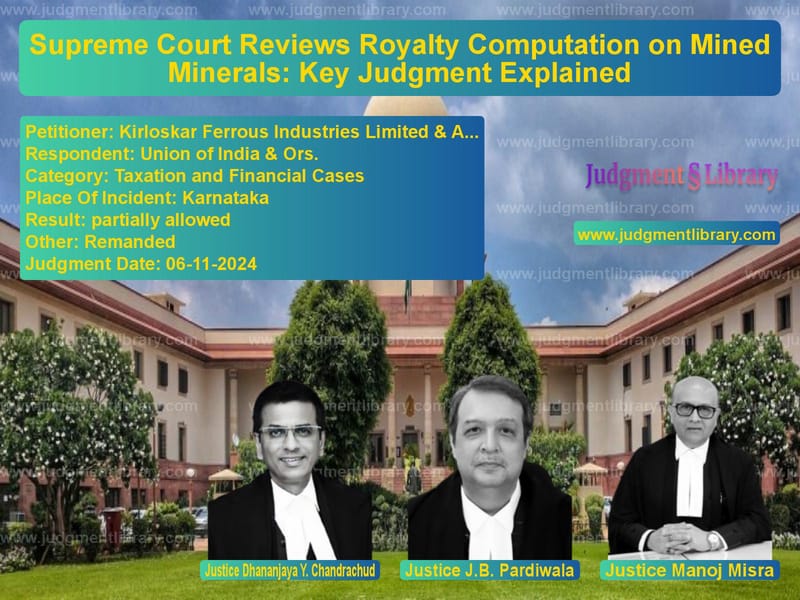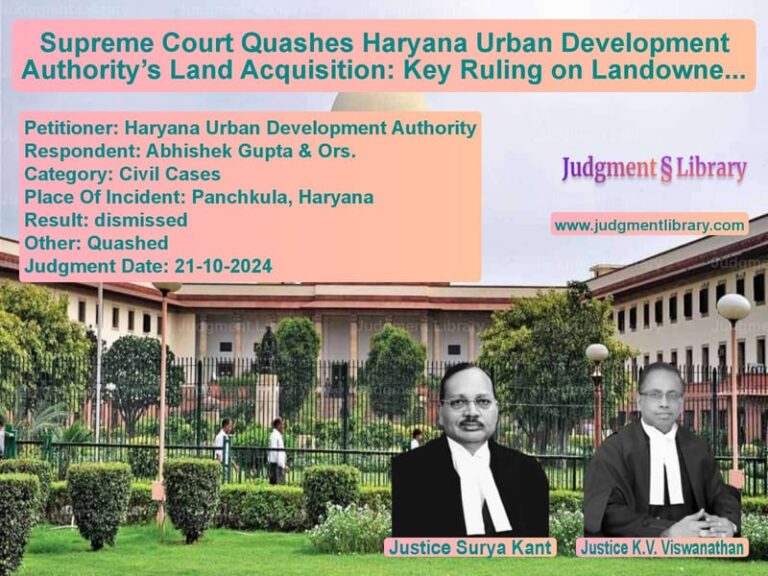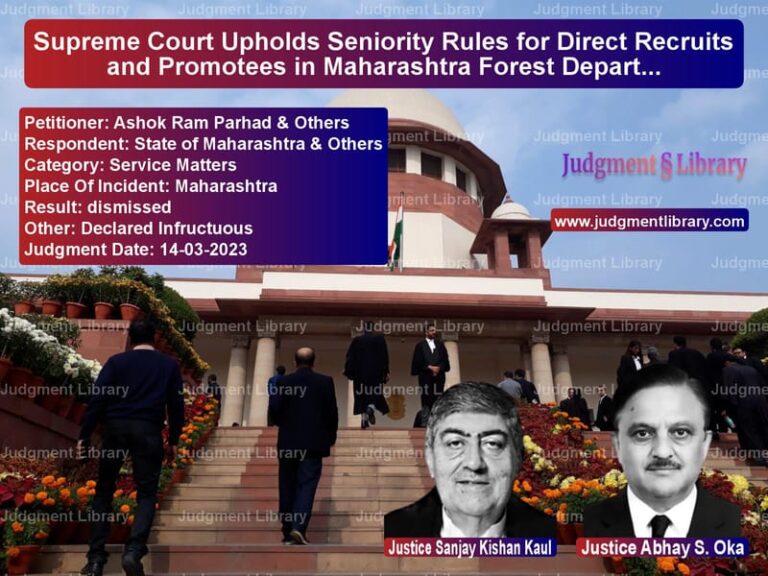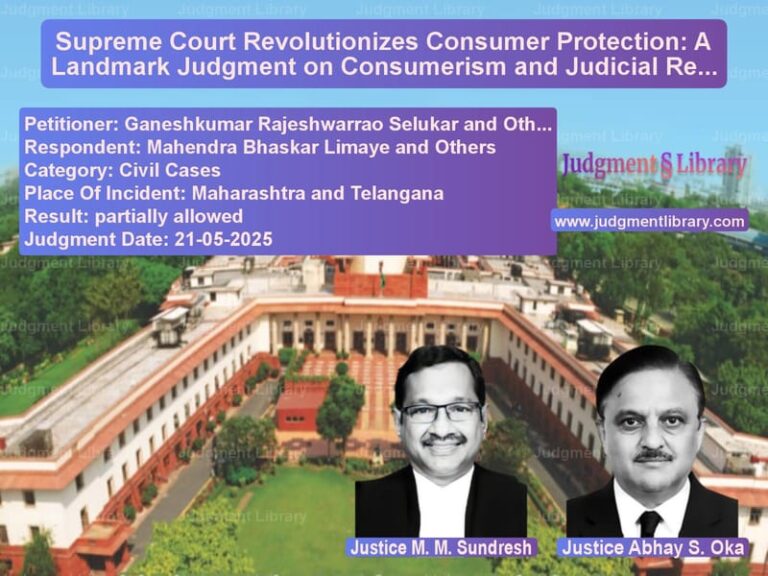Supreme Court Reviews Royalty Computation on Mined Minerals: Key Judgment Explained
The case of Kirloskar Ferrous Industries Limited & Anr. vs. Union of India & Ors. challenged the validity of certain provisions under the Mineral Concession Rules, 2016 (MCR, 2016) and the Mineral Conservation and Development Rules, 2017 (MCDR, 2017). The core issue was whether the inclusion of previously paid royalties and contributions to the District Mineral Foundation (DMF) and National Mineral Exploration Trust (NMET) in the computation of royalty for subsequent months was lawful. The Supreme Court addressed whether this practice led to an unfair cascading effect and violated constitutional principles.
Background of the Case
Kirloskar Ferrous Industries Limited, a mining leaseholder, extracted pig iron and associated byproducts under a lease granted in Karnataka. The company, alongside a shareholder, filed a writ petition under Article 32 of the Constitution against the Union of India and the Indian Bureau of Mines, challenging the methodology of royalty computation. The petitioners argued that the prevailing system effectively imposed a ‘royalty on royalty,’ leading to inflated costs.
Legal Framework
The case revolved around the provisions of:
- The Mines and Minerals (Development and Regulation) Act, 1957 (MMDR Act)
- The Mineral Concession Rules, 2016 (MCR, 2016)
- The Mineral Conservation and Development Rules, 2017 (MCDR, 2017)
Under the MMDR Act, Section 9 mandates the payment of royalty for minerals extracted from leasehold areas at rates specified in the Second Schedule. The Central Government has the authority to revise royalty rates every three years. The MCR, 2016 and MCDR, 2017 define the methods for computing sale value and average sale price of minerals.
Petitioners’ Arguments
Senior Counsel Dr. A.M. Singhvi, representing the petitioners, presented the following key arguments:
- The inclusion of previously paid royalty, DMF, and NMET contributions in the computation of subsequent royalties results in an unfair compounding effect.
- The provisions under MCR, 2016 and MCDR, 2017 artificially inflate the royalty payable, violating Article 14 of the Constitution.
- The exclusion of coal from this methodology while applying it to iron ore and other minerals is arbitrary and discriminatory.
- The Central Government acknowledged this issue in a 2022 consultation paper but failed to take corrective action.
- The methodology contradicts established legal principles that prohibit charging a tax on a tax-like mechanism.
Respondents’ Arguments
The Union of India, represented by Additional Solicitor General Mr. Shailesh Madiyal, defended the existing methodology:
- Royalty is not a tax but a consideration for extracting minerals, and its computation method is a policy decision.
- The government has the legislative authority to determine royalty computation, and courts should not intervene in economic policymaking.
- The methodology does not cause a cumulative effect, as the average sale price varies each month.
- Any revision of the rules should be done through legislative processes rather than judicial review.
- Public consultations are ongoing, and the government is actively considering amendments to address the issue.
Supreme Court’s Observations
The Supreme Court examined the legal and policy implications of the contested provisions. The key findings were:
1. Compounding Effect of Royalty
The Court noted that the computation method effectively resulted in a cascading charge, leading to a re-imposition of royalty on previously paid amounts. This issue was acknowledged by the government in a consultation paper but remained unaddressed.
2. Differentiation Between Coal and Other Minerals
The Court observed that excluding coal from this methodology while applying it to other minerals lacked a rational basis. It referred to previous judgments affirming that all minerals should be treated equitably under the MMDR Act.
3. Policy vs. Judicial Intervention
The Court reiterated that policy decisions should generally remain within the executive’s domain. However, it emphasized that when a policy results in unfair or arbitrary outcomes, judicial review is warranted.
Judgment
The Supreme Court did not strike down the contested provisions outright but directed the government to expedite the review process:
- The Court granted the government two months to conclude the public consultation process and decide on potential amendments.
- The petitioners retain the right to challenge the final policy decision if it does not address their concerns.
- The Court will revisit the matter after two months to assess compliance with its directive.
Impact of the Judgment
The ruling underscores the balance between judicial restraint and intervention in policy matters. While economic policymaking falls within the executive’s domain, the Court signaled that policies leading to inequitable financial burdens require scrutiny.
Key takeaways include:
- Mining leaseholders may see potential relief if the government revises the royalty computation methodology.
- The decision sets a precedent for judicial review of economic policies that result in disproportionate financial burdens.
- Future amendments to the MMDR Act and related rules could ensure uniformity across different minerals.
Overall, this judgment represents a significant development in the interpretation of royalty laws in India’s mining sector. The final outcome now hinges on the government’s response within the stipulated timeframe.
Petitioner Name: Kirloskar Ferrous Industries Limited & Anr..Respondent Name: Union of India & Ors..Judgment By: Justice Dhananjaya Y. Chandrachud, Justice J.B. Pardiwala, Justice Manoj Misra.Place Of Incident: Karnataka.Judgment Date: 06-11-2024.
Don’t miss out on the full details! Download the complete judgment in PDF format below and gain valuable insights instantly!
Download Judgment: kirloskar-ferrous-in-vs-union-of-india-&-ors-supreme-court-of-india-judgment-dated-06-11-2024.pdf
Directly Download Judgment: Directly download this Judgment
See all petitions in Customs and Excise
See all petitions in Tax Refund Disputes
See all petitions in Banking Regulations
See all petitions in Judgment by Dhananjaya Y Chandrachud
See all petitions in Judgment by J.B. Pardiwala
See all petitions in Judgment by Manoj Misra
See all petitions in partially allowed
See all petitions in Remanded
See all petitions in supreme court of India judgments November 2024
See all petitions in 2024 judgments
See all posts in Taxation and Financial Cases Category
See all allowed petitions in Taxation and Financial Cases Category
See all Dismissed petitions in Taxation and Financial Cases Category
See all partially allowed petitions in Taxation and Financial Cases Category







